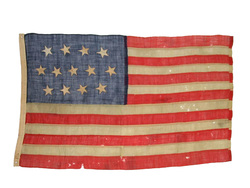

Obverse - 2
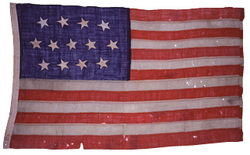
Book Photo
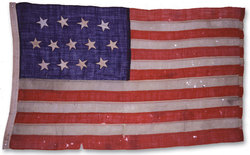
Obverse
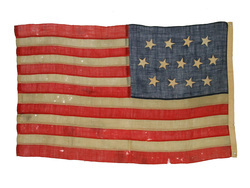
REVERSE

Obverse - 3
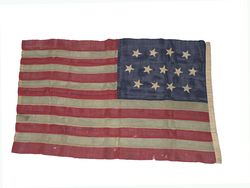
Reverse
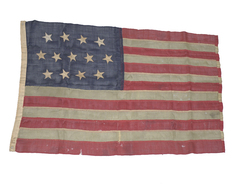
Obverse
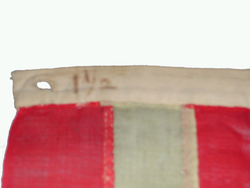
Ob. Lower Hoist
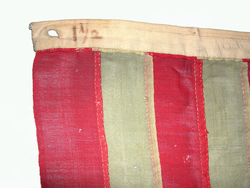
Ob. Lower Hoist - 2










U.S. 13 stars 4-5-4 pattern Flag, Merchant Ensign.
Sub-collection: Guthman / Early American13 Star U.S. Merchant Ensign, 4-5-4 Star design, Early Federal Period.
The early history of this flag is unknown, but it originates from the personal collection of noted collector William H. Guthman, founder of Guthman Americana in Westport, Connecticut where he was a respected dealer, scholar and author, and was considered a preeminent authority on Colonial and Federal period militaria.
Bill Guthman, an American-history buff since his youth, became interested in military antiques in 1966 from his profession as a textile-manufacturing executive. As a prominent antiques dealer he came to specialize in historical military Americana and helped make them noticed in the collecting world. Mr. Guthman collected artifacts of the French, Indian and American Revolutionary Wars; and was one of the very first individuals to consider militaria as folk art.
There is probably no other 13 star American flag better known to the general public than the "Betsy Ross design" with its 13 red and white stripes and single ring of 13, white 5-point stars. Historians today think that most such flags date from the years 1777-1795, when the 13 star flag was official had rows of stars and not constellations. The reason for this, on sewn flags, was largely practical. It is easier to sew stars onto flags in rows rather than geometric shapes. The five point star is easier to make and easier to see. Evidenced by surviving examples and period illustrations documenting 18th century arrangement for the stars in the United States flag, the 4-5-4 star pattern is both one of the first and one of the most common designs.
Both stars and stripes stood for the 13 original states - Delaware, Pennsylvania, New Jersey, Georgia, Connecticut, Massachusetts, Maryland, South Carolina, New Hampshire, Virginia, New York, North Carolina and Rhode Island. During the administration of President Thomas Jefferson (1801-1809) the United States purchased the Louisiana Territory from France. The Lewis and Clark Expedition during those years laid the basis for later American claims to sovereignty in the West.
This flag may well be one of the earliest United States flags in the Zaricor Flag Collection. While the use of cotton stars suggests to some production after 1800; recent scholarship indicates both the presence and use of cotton threads prior to 1793. Recent textile analysis suggests this flag is contemporary of the revolution period (circa 1800). The woolen stripes have selvedges typical of early hand-loomed material and the flag is hand-stitched. The finishing details indicate that a professional manufacturer made this flag, e.g. the finely crafted linen hand whipped-stitched eyelets on the hoist. Interestingly, the marking "1 ½" on the flags cotton heading refers to a flag manufactured to specific fly dimensions; in this case one and a half yards or 54". As a result of extensive usage, the fly has been trimmed and sewn again and is now only 48". The sizeable marking on the heading is more typical of flags manufactured as stock items rather than individually handcrafted on special order. One of the earliest identified flag manufacturers in the United States was Rebecca Young of Philadelphia and Baltimore. She advertised in the newspapers around 1803 that she had ready-made flags. This flag might well be one of her products.
Exhibition History:
First Presidio Exhibit
Thirteen-Star, United States Merchant Ships Ensign
Second Presidio Exhibit Gallery One Copy 2003
13-Star United States Merchant Ship Ensign
Private Showing
Night of Flags in celebration of George Washington's Birthday
The National Society of The Colonial Dames of America in California
Patriotic Services Committee
Thursday, February 26, 2009
Octagon House, San Francisco
5:30pm - 7:30pm
Publication History:
Crump, Anne, David Studarus, photographer, "A Grand Old Obsession." American Spirit: Daughters of the American revolution Magazine: July/August 2003: P.20.
Madaus, Howard M., Dr, Whitney Smith, The American Flag: Two Centuries of Concord and Conflict. Santa Cruz: VZ Publications, 2006, p. 17.
Provenance:
• William Guthman of Westport, CT, until 1992.
• Acquired by purchase by the Zaricor Flag Collection, 1992.
ZFC Significant Flag
Item is Framed
Sources:
Madaus, Howard M.- Whitney Smith, The American Flag: Two Centuries of Concord and Conflict, VZ Publications, Santa Cruz, 2006. P 17.
Goody, Rabbit, ZFC2497 Analysis Report, examination and research for Ben Zaricor, April 2009, Zaricor Flag Collection Archives
Beach, Laura, Noted Scholar and Dealer William H. Guthman Dies, Antiques and Arts Online, 24 October 2011, from:
http://antiquesandthearts.com/Antiques/TradeTalk/2006-01-03__07-52-07.html
The William Guthman Collection, 24 October 2011, from:
http://www.fielddrums.com/Guthman
The William Guthman Sale, Maine Antique Digest, 24 October 2011, from: http://maineantiquedigest.com/articles_archive/articles/mar03/guth0303.htm
Image Credits:
Zaricor Flag Collection
Hoist & Fly | |
|---|---|
| Width of Hoist | 30.675 |
| Length of Fly | 49.25 |
Union/Canton | |
|---|---|
| Width of Union/Canton | 15.75 |
| Length of Union/Canton | 21 |
Stars | |
|---|---|
| Comments on Star Measurements | Sizes of all stars vary slightly |
| Size of Stars | 2.5 |
Stripes | |
|---|---|
| Width of 1st Stripe | 3 |
| Width of 3rd Stripe | 3 |
| Width of 8th Stripe | 2.25 |
| Width of Last Stripe | 2.75 |
| Size of Hoist | 1.25 |
Frame | |
|---|---|
| Is it framed? | yes |
| Frame Height | 37 |
| Frame Length | 58 |
Stars | |
|---|---|
| Number of Stars | 13 |
| How are the stars embeded? | Double Applique |
| Are there stars on obverse? | yes |
| Are there stars on reverse? | yes |
| Comments on Stars | 4-5-4 in horizontal rows |
Stripes | |
|---|---|
| Number of Stripes | 13 |
| Color of Top Stripe | Red |
| Color of Bottom Stripe | Red |
| Has a Blood Stripe? | no |
| Comments on Stripes | Hand stitched. |
Nationality | |
|---|---|
| Nation Represented | United States |
Fabric | |
|---|---|
| Fabric | Wool |
| Comments on Fabric | Fabric very sheer, Single ply over single ply Bunting |
Stitching | |
|---|---|
| Stitching | Hand |
Thread | |
|---|---|
| Type of Thread | 2 Ply |
| Thread Material | Linen |
| Comments on Thread Material | All original thread is 2ply linen. There is a canton repair with synthetic & cotton threads. |
| Field Thread | Hand Spun |
Weave | |
|---|---|
| Type of Weave | Plain |
Attachment | |
|---|---|
| Comments on Method of Attachmen | well made, "professional" construction on both hoist and eyelets. Eyelet or grommet through header |
| Method of Attachment | Whip-stitched |
Applica | |
|---|---|
| Applique Sides | Single Faced = Mirror Image Reverse |
Documentation | |
|---|---|
| Documents | |
| Drawings | |
| Research Documents | |
| Public Copy & Signs | |
| Press | |
Condition | |
|---|---|
| Condition | Good |
| Damage | Small moth holes in all stripes except 3rd and 9th. Some staining in the lower regions of the flag. |
| Displayable | yes |
Date | |
|---|---|
| Date | Circa 1790's |
Exhibits | |
|---|---|
| Exhibition Copy | First Presidio Exhibit (ZFC0419) THIRTEEN-STAR, UNITED STATES MERCHANT SHIP'S ENSIGN Date: Probably mid-Federal Period (1800-1805) Media: Wool bunting and cotton stars; all hand stitched Comment: This flag may well be the earliest United States flag in the Zaricor Flag Collection. The use of cotton stars suggests production after 1800; the woolen stripes have selvedge edges typical of early power looms and the flag is hand stitched. While it has been suggested that the flag could be even earlier than 1800, the marking "1 1/2" on the flag's linen heading refers to a flag manufactured to a specific fly dimension - one and a half yards, i.e. 54" (The flag's fly has been trimmed and resewn to a length of 48".) The size marking on the heading is more typical of flags manufactured as a "stock item" rather than individually hand crafted on special order. The earliest identified flag manufacturer in the United States was Rebecca Young of Philadelphia and Baltimore, who advertised in the contemporary newspapers about 1803 that she had on hand, ready-made flags. This flag may be one of her products. Provenance: Acquired by the Zaricor Flag Collection (ZFC0419) in 1992 from William Guthman of Westport, CT. Second Presidio Exhibit Gallery One Copy - 2003 ZFC0419 13-Star United States Merchant Ship Ensign Date: Probably mid-Federal Period (1800-1805) Media: Wool bunting and cotton stars; hand-stitched Comment: This flag may well be the earliest United States flag in the Zaricor Flag Collection. The use of cotton stars suggests production after 1800; the woolen stripes have selvedges typical of early power-loomed material and the flag is hand-stitched. It has been suggested that the flag could date even earlier than 1800. However, the marking 1 1/2 on the flag's linen heading refers to a flag manufactured to a specific fly dimension-in this case one and a half yards or 54". As a result of extensive usage, the fly has been trimmed and resewn and is now only 48". The size marking on the heading is more typical of flags manufactured as stock items rather than individually hand-crafted on special order. One of the earliest identified flag manufacturers in the United States was Rebecca Young of Philadelphia and Baltimore. She advertised in the newspapers around 1803 that she had on hand ready-made flags and this flag may be one of her products. Provenance: Acquired by the Zaricor Flag Collection (ZFC0419) in 1992 from William Guthman of Westport, CT. Night of Flags In celebration of George Washington's Birthday The National Society of The Colonial Dames of America in California Patriotic Services Committee James Ferrigan, Curator, Flag Center Ben Zaricor, Director, Flag Center Thursday, February 26, 2009 Octagon House, San Francisco 5:30pm - 7:30 pm This was a power point slide presentation on the period 13 star flag and Presidential flags in the Flag Center/Zaricor Flag Collection and comments by Ben Zaricor wherein the image of this flag was displayed. |
Publications | |
|---|---|
| Publication Copy | Crump, Anne, David Studarus, photographer, "A Grand Old Obsession." American Spirit: Daughters of the American revolution Magazine: July/August 2003: P.20. (see images below) Madaus, Howard M., Dr, Whitney Smith, The American Flag: Two Centuries of Concord and Conflict. Santa Cruz: VZ Publications, 2006, p. 17. 13-Star United States Merchant Ship Ensign This flag is one of the earliest United States flags in the Zaricor Flag Collection. The use of cotton stars suggests production after 1799; the woolen stripes have selvedges typical of early power-loomed material and the flag is hand-stitched. It has been suggested that the flag could date even earlier than 1800. The marking "11â„2" on the flag's linen heading refers to a flag manufactured to a specific fly dimension-in this case one and a half yards or 54". As a result of extensive usage, the fly has been trimmed and resewn and is now only 48". The size marking on the heading is more typical of flags manufactured as stock items rather than individually hand-crafted on special order. One of the earliest identified flag manufacturers in the United States was Rebecca Young of Philadelphia and Baltimore. She advertised in the newspapers around |







































